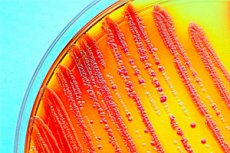Nye publikasjoner
Nytt lite molekyl gir håp i kampen mot antibiotikaresistens
Sist anmeldt: 02.07.2025

Alt iLive-innhold blir gjennomgått med medisin eller faktisk kontrollert for å sikre så mye faktuell nøyaktighet som mulig.
Vi har strenge retningslinjer for innkjøp og kun kobling til anerkjente medieområder, akademiske forskningsinstitusjoner og, når det er mulig, medisinsk peer-evaluerte studier. Merk at tallene i parenteser ([1], [2], etc.) er klikkbare koblinger til disse studiene.
Hvis du føler at noe av innholdet vårt er unøyaktig, utdatert eller ellers tvilsomt, velg det og trykk Ctrl + Enter.

Forskere ved University of Oxford har utviklet et nytt lite molekyl som kan undertrykke utviklingen av antibiotikaresistens hos bakterier og gjøre resistente bakterier mer mottakelige for antibiotika. Resultatene av studien ble publisert i tidsskriftet Chemical Science.
Den globale økningen av antibiotikaresistente bakterier er en av de største truslene mot folkehelsen og utviklingen, ettersom mange vanlige infeksjoner blir stadig vanskeligere å behandle. Medikamentresistente bakterier er allerede direkte ansvarlige for rundt 1,27 millioner dødsfall over hele verden hvert år og bidrar til ytterligere 4,95 millioner dødsfall. Uten rask utvikling av nye antibiotika og antimikrobielle midler vil dette tallet øke betydelig.
En ny studie utført av forskere fra Ineos Oxford Institute for Antimicrobial Research (IOI) og Department of Pharmacology ved University of Oxford gir håp om å oppdage et lite molekyl som fungerer i kombinasjon med antibiotika for å undertrykke utviklingen av medikamentresistens hos bakterier.
En måte bakterier blir resistente mot antibiotika på er gjennom nye mutasjoner i deres genetiske kode. Noen antibiotika (som fluorokinoloner) virker ved å skade bakteriens DNA, noe som fører til at cellene dør. Denne DNA-skaden kan imidlertid utløse en prosess kjent som «SOS-responsen» hos de berørte bakteriene. SOS-responsen reparerer skadet DNA i bakterier og øker frekvensen av genetiske mutasjoner, noe som kan fremskynde utviklingen av antibiotikaresistens. I en ny studie har forskere ved Oxford identifisert et molekyl som kan hemme SOS-responsen, og dermed øke effektiviteten til antibiotika mot disse bakteriene.
Forskerne studerte en rekke molekyler som tidligere har vært rapportert å øke følsomheten til meticillinresistente Staphylococcus aureus (MRSA) for antibiotika og forhindre MRSA SOS-responsen. MRSA er en type bakterie som normalt lever ufarlig på huden. Men hvis den kommer inn i kroppen, kan den forårsake en alvorlig infeksjon som krever øyeblikkelig antibiotikabehandling. MRSA er resistent mot alle betalaktamantibiotika, som penicilliner og cefalosporiner.
Forskerne modifiserte strukturen til ulike deler av molekylet og testet aktiviteten deres mot MRSA i kombinasjon med ciprofloksacin, et fluorokinolonantibiotikum. Dette tillot dem å identifisere det kraftigste SOS-responshemmermolekylet, kalt OXF-077. Kombinert med ulike antibiotika fra ulike klasser gjorde OXF-077 dem mer effektive til å forhindre synlig vekst av MRSA-bakterier.
I et viktig funn testet teamet deretter følsomheten til bakterier behandlet med ciprofloksacin i flere dager for å bestemme hvor raskt antibiotikaresistens utviklet seg med eller uten OXF-077. De fant at fremveksten av ciprofloksacinresistens ble betydelig undertrykt hos bakterier behandlet med OXF-077 sammenlignet med de som ikke ble behandlet med OXF-077. Dette er den første studien som viser at en SOS-responshemmer kan undertrykke utviklingen av antibiotikaresistens hos bakterier. Dessuten, når tidligere ciprofloksacinresistente bakterier ble behandlet med OXF-077, ble deres følsomhet for antibiotikaen gjenopprettet til nivået til bakterier som ikke hadde utviklet resistens.
Disse resultatene tyder på at OXF-077 er et nyttig verktøymolekyl for å utforske effektene av å hemme SOS-responsen hos bakterier og for å behandle antibiotikaresistente infeksjoner. Ytterligere studier er nødvendige for å teste egnetheten til disse molekylene for bruk utenfor laboratoriet, og dette vil være en del av det pågående arbeidet mellom IOI og Institutt for farmakologi ved Oxford for å utvikle nye molekyler for å bremse og/eller reversere utviklingen av antibiotikaresistens.
